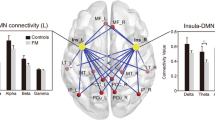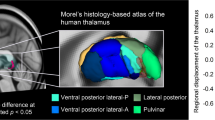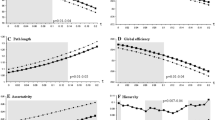Abstract
Purpose
Neuroimaging studies employing analyses dependent on regional assumptions and specific neuronal circuits could miss characteristics of whole-brain structural connectivity critical to the pathophysiology of fibromyalgia (FM). This study applied the whole-brain graph-theoretical approach to identify whole-brain structural connectivity disturbances in FM.
Methods
This cross-sectional study used probabilistic diffusion tractography and graph theory analysis to evaluate the topological organization of brain white matter networks in 20 patients with FM and 20 healthy controls (HCs). The relationship between brain network metrics and clinical variables was evaluated.
Results
Compared with HCs, FM patients had lower clustering coefficient, local efficiency, hierarchy, synchronization, and higher normalized characteristic path length. Regionally, patients demonstrated a significant reduction in nodal efficiency and centrality; these regions were mainly located in the prefrontal, temporal cortex, and basal ganglia. The network-based statistical analysis (NBS) identified decreased structural connectivity in a subnetwork of prefrontal cortex, basal ganglia, and thalamus in FM. There was no correlation between network metrics and clinical variables (false discovery rate corrected).
Conclusions
The current research demonstrated disrupted topological architecture of white matter networks in FM. Our results suggested compromised neural integration and segregation and reduced structural connectivity in FM.




Similar content being viewed by others
Data availability
Data are available from a public dataset via OpenNeuro with accession number ds001928 (https://openneuro.org/datasets/ds001928/versions/1.1.0).
References
Wolfe F, Clauw DJ, Fitzcharles MA, Goldenberg DL, Hauser W, Katz RS, Mease P, Russell AS, Russell IJ, Winfield JB (2011) Fibromyalgia criteria and severity scales for clinical and epidemiological studies: a modification of the ACR Preliminary Diagnostic Criteria for Fibromyalgia. J Rheumatol 38:1113–1122
Kim J, Loggia ML, Cahalan CM, Harris RE, Beissner FDPN, Garcia RG, Kim H, Wasan AD, Edwards RR, Napadow V (2015) The somatosensory link in fibromyalgia: functional connectivity of the primary somatosensory cortex is altered by sustained pain and is associated with clinical/autonomic dysfunction. Arthritis Rheumatol 67:1395–1405
van Ettinger-Veenstra H, Boehme R, Ghafouri B, Olausson H, Wicksell RK, Gerdle B (2020) Exploration of functional connectivity changes previously reported in fibromyalgia and their relation to psychological distress and pain measures. J Clin Med 9:3560
Cifre I, Sitges C, Fraiman D, Munoz MA, Balenzuela P, Gonzalez-Roldan A, Martinez-Jauand M, Birbaumer N, Chialvo DR, Montoya P (2012) Disrupted functional connectivity of the pain network in fibromyalgia. Psychosom Med 74:55–62
Tu Y, Wang J, Xiong F, Gao F (2022) Cortical abnormalities in patients with fibromyalgia: a pilot study of surface-based morphometry analysis. Pain Med 23(12):1939–1946
Basser PJ, Mattiello J, LeBihan D (1994) MR diffusion tensor spectroscopy and imaging. Biophys J 66:259–267
Ceko M, Bushnell MC, Fitzcharles MA, Schweinhardt P (2013) Fibromyalgia interacts with age to change the brain. Neuroimage Clin 3:249–260
Lutz J, Jager L, de Quervain D, Krauseneck T, Padberg F, Wichnalek M, Beyer A, Stahl R, Zirngibl B, Morhard D, Reiser M, Schelling G (2008) White and gray matter abnormalities in the brain of patients with fibromyalgia: a diffusion-tensor and volumetric imaging study. Arthritis Rheum 58:3960–3969
Kim DJ, Lim M, Kim JS, Son KM, Kim HA, Chung CK (2014) Altered white matter integrity in the corpus callosum in fibromyalgia patients identified by tract-based spatial statistical analysis. Arthritis Rheumatol 66:3190–3199
Hagmann P, Cammoun L, Gigandet X, Meuli R, Honey CJ, Wedeen VJ, Sporns O (2008) Mapping the structural core of human cerebral cortex. PLoS Biol 6:e159
Bullmore E, Sporns O (2009) Complex brain networks: graph theoretical analysis of structural and functional systems. Nat Rev Neurosci 10:186–198
Kim SH, Lee MW, Kang MJ, Lee SG, Lee JG, Mun CW (2020) Comparison analysis between the medication efficacy of the milnacipran and functional connectivity of neural networks in fibromyalgia patients. Brain Sci 10:295
Kim H, Kim J, Loggia ML, Cahalan C, Garcia RG, Vangel MG, Wasan AD, Edwards RR, Napadow V (2015) Fibromyalgia is characterized by altered frontal and cerebellar structural covariance brain networks. Neuroimage Clin 7:667–677
Pando-Naude V, Barrios FA, Alcauter S, Pasaye EH, Vase L, Brattico E, Vuust P, Garza-Villarreal EA (2019) Functional connectivity of music-induced analgesia in fibromyalgia. Sci Rep 9:15486
Garcia Campayo J, Rodero B, Alda M, Sobradiel N, Montero J, Moreno S (2008) Validation of the Spanish version of the Pain Catastrophizing Scale in fibromyalgia. Med Clin (Barc) 131:487–492
Kendall PC, Finch AJ Jr, Auerbach SM, Hooke JF, Mikulka PJ (1976) The State-Trait Anxiety Inventory: a systematic evaluation. J Consult Clin Psychol 44:406–412
Smarr KL, Keefer AL (2011) Measures of depression and depressive symptoms: Beck Depression Inventory-II (BDI-II), Center for Epidemiologic Studies Depression Scale (CES-D), Geriatric Depression Scale (GDS), Hospital Anxiety and Depression Scale (HADS), and Patient Health Questionnaire-9 (PHQ-9). Arthritis Care Res (Hoboken) 63(Suppl 11):S454–S466
Cui Z, Zhong S, Xu P, He Y, Gong G (2013) PANDA: a pipeline toolbox for analyzing brain diffusion images. Front Hum Neurosci 7:42
Behrens TE, Berg HJ, Jbabdi S, Rushworth MF, Woolrich MW (2007) Probabilistic diffusion tractography with multiple fibre orientations: What can we gain? Neuroimage 34:144–155
Tzourio-Mazoyer N, Landeau B, Papathanassiou D, Crivello F, Etard O, Delcroix N, Mazoyer B, Joliot M (2002) Automated anatomical labeling of activations in SPM using a macroscopic anatomical parcellation of the MNI MRI single-subject brain. Neuroimage 15:273–289
Pan Y, Liu Z, Xue Z, Sheng Y, Cai Y, Cheng Y, Chen X (2022) Abnormal network properties and fiber connections of DMN across major mental disorders: a probability tracing and graph theory study. Cereb Cortex 32:3127–3136
Li L, Lei D, Suo X, Li X, Yang C, Yang T, Ren J, Chen G, Zhou D, Kemp GJ, Gong Q (2020) Brain structural connectome in relation to PRRT2 mutations in paroxysmal kinesigenic dyskinesia. Hum Brain Mapp 41:3855–3866
Suo X, Lei D, Chen F, Wu M, Li L, Sun L, Wei X, Zhu H, Li L, Kemp GJ, Gong Q (2017) Anatomic insights into disrupted small-world networks in pediatric posttraumatic stress disorder. Radiology 282:826–834
Xia M, Wang J, He Y (2013) BrainNet Viewer: a network visualization tool for human brain connectomics. PloS One 8:e68910
Meng C, Brandl F, Tahmasian M, Shao J, Manoliu A, Scherr M, Schwerthoffer D, Bauml J, Forstl H, Zimmer C, Wohlschlager AM, Riedl V, Sorg C (2014) Aberrant topology of striatum's connectivity is associated with the number of episodes in depression. Brain 137:598–609
Lynall ME, Bassett DS, Kerwin R, McKenna PJ, Kitzbichler M, Muller U, Bullmore E (2010) Functional connectivity and brain networks in schizophrenia. J Neurosci 30:9477–9487
Jung WH, Yucel M, Yun JY, Yoon YB, Cho KI, Parkes L, Kim SN, Kwon JS (2017) Altered functional network architecture in orbitofronto-striato-thalamic circuit of unmedicated patients with obsessive-compulsive disorder. Hum Brain Mapp 38:109–119
Wang Y, Deng F, Jia Y, Wang J, Zhong S, Huang H, Chen L, Chen G, Hu H, Huang L, Huang R (2019) Disrupted rich club organization and structural brain connectome in unmedicated bipolar disorder. Psychol Med 49:510–518
Zalesky A, Fornito A, Bullmore ET (2010) Network-based statistic: identifying differences in brain networks. Neuroimage 53:1197–1207
Watts DJ, Strogatz SH (1998) Collective dynamics of 'small-world' networks. Nature 393:440–442
Rubinov M, Sporns O (2010) Complex network measures of brain connectivity: uses and interpretations. Neuroimage 52:1059–1069
Zhang Y, Liu J, Li L, Du M, Fang W, Wang D, Jiang X, Hu X, Zhang J, Wang X, Fang J (2014) A study on small-world brain functional networks altered by postherpetic neuralgia. Magn Reson Imaging 32:359–365
Huang X, Chen J, Liu S, Gong Q, Liu T, Lu C, Qin Z, Cui H, Chen Y, Zhu Y (2021) Impaired frontal-parietal control network in chronic prostatitis/chronic pelvic pain syndrome revealed by graph theoretical analysis: A DTI study. Eur J Neurosci 53:1060–1071
Supekar K, Musen M, Menon V (2009) Development of large-scale functional brain networks in children. PLoS Biol 7:e1000157
Lee SJ, Song HJ, Decety J, Seo J, Kim SH, Kim SH, Nam EJ, Kim SK, Han SW, Lee HJ, Do Y, Chang Y (2013) Do patients with fibromyalgia show abnormal neural responses to the observation of pain in others? Neurosci Res 75:305–315
Burgmer M, Pogatzki-Zahn E, Gaubitz M, Wessoleck E, Heuft G, Pfleiderer B (2009) Altered brain activity during pain processing in fibromyalgia. Neuroimage 44:502–508
Mouraux A, Diukova A, Lee MC, Wise RG, Iannetti GD (2011) A multisensory investigation of the functional significance of the "pain matrix". Neuroimage 54:2237–2249
Tracey I (2005) Nociceptive processing in the human brain. Curr Opin Neurobiol 15:478–487
Nachev P, Wydell H, O'Neill K, Husain M, Kennard C (2007) The role of the pre-supplementary motor area in the control of action. Neuroimage 36(Suppl 2):T155–T163
Sumner P, Nachev P, Morris P, Peters AM, Jackson SR, Kennard C, Husain M (2007) Human medial frontal cortex mediates unconscious inhibition of voluntary action. Neuron 54:697–711
Friebel U, Eickhoff SB, Lotze M (2011) Coordinate-based meta-analysis of experimentally induced and chronic persistent neuropathic pain. Neuroimage 58:1070–1080
Loggia ML, Berna C, Kim J, Cahalan CM, Gollub RL, Wasan AD, Harris RE, Edwards RR, Napadow V (2014) Disrupted brain circuitry for pain-related reward/punishment in fibromyalgia. Arthritis Rheumatol 66:203–212
Glass JM, Williams DA, Fernandez-Sanchez ML, Kairys A, Barjola P, Heitzeg MM, Clauw DJ, Schmidt-Wilcke T (2011) Executive function in chronic pain patients and healthy controls: different cortical activation during response inhibition in fibromyalgia. J Pain 12:1219–1229
Borsook D, Upadhyay J, Chudler EH, Becerra L (2010) A key role of the basal ganglia in pain and analgesia--insights gained through human functional imaging. Mol Pain 6:27
Starr CJ, Sawaki L, Wittenberg GF, Burdette JH, Oshiro Y, Quevedo AS, McHaffie JG, Coghill RC (2011) The contribution of the putamen to sensory aspects of pain: insights from structural connectivity and brain lesions. Brain 134:1987–2004
Leung A, Shirvalkar P, Chen R, Kuluva J, Vaninetti M, Bermudes R, Poree L, Wassermann EM, Kopell B, Levy R, the Expert Consensus P (2020) Transcranial magnetic stimulation for pain, headache, and comorbid depression: INS-NANS Expert Consensus Panel Review and Recommendation. Neuromodulation 23:267–290
Argaman Y, Granovsky Y, Sprecher E, Sinai A, Yarnitsky D, Weissman-Fogel I (2021) Clinical effects of repetitive transcranial magnetic stimulation of the motor cortex are associated with changes in resting-state functional connectivity in patients with fibromyalgia syndrome. J Pain 23(4):595–615
Khedr EM, Omran EAH, Ismail NM, El-Hammady DH, Goma SH, Kotb H, Galal H, Osman AM, Farghaly HSM, Karim AA, Ahmed GA (2017) Effects of transcranial direct current stimulation on pain, mood and serum endorphin level in the treatment of fibromyalgia: A double blinded, randomized clinical trial. Brain Stimul 10:893–901
Cummiford CM, Nascimento TD, Foerster BR, Clauw DJ, Zubieta JK, Harris RE, DaSilva AF (2016) Changes in resting state functional connectivity after repetitive transcranial direct current stimulation applied to motor cortex in fibromyalgia patients. Arthritis Res Ther 18:40
Fagerlund AJ, Hansen OA, Aslaksen PM (2015) Transcranial direct current stimulation as a treatment for patients with fibromyalgia: a randomized controlled trial. Pain 156:62–71
Lorenz J, Minoshima S, Casey KL (2003) Keeping pain out of mind: the role of the dorsolateral prefrontal cortex in pain modulation. Brain 126:1079–1091
Brown CA, El-Deredy W, Jones AK (2014) When the brain expects pain: common neural responses to pain anticipation are related to clinical pain and distress in fibromyalgia and osteoarthritis. Eur J Neurosci 39:663–672
Caumo W, Alves RL, Vicuna P, Alves C, Ramalho L, Sanches PRS, Silva DP, da Silva Torres IL, Fregni F (2021) Impact of bifrontal home-based transcranial direct current stimulation in pain catastrophizing and disability due to pain in fibromyalgia: a randomized, double-blind sham-controlled study. J Pain 23(4):641–656
Flodin P, Martinsen S, Lofgren M, Bileviciute-Ljungar I, Kosek E, Fransson P (2014) Fibromyalgia is associated with decreased connectivity between pain- and sensorimotor brain areas. Brain Connect 4:587–594
Acknowledgments
We thank all the participants in this study.
Funding
None.
Author information
Authors and Affiliations
Corresponding authors
Ethics declarations
Conflict of interest
None of the authors of this manuscript has any potential conflict of interest related to the content of this study.
Ethics approval
This research was approved by the Ethics Committee of the Bioethics Committee of the Institute of Neurobiology, UNAM Juriquilla, Queretaro, Mexico.
Consent to participate
Informed consent was obtained from all individual participants included in the study.
Additional information
Publisher’s Note
Springer Nature remains neutral with regard to jurisdictional claims in published maps and institutional affiliations.
Supplementary information

ESM 1
Supplementary material The symmetric weighted matrix of representative subject of each group. A = representative subject of fibromyalgia group, B = representative subject of healthy control group. (PNG 418 kb)
Rights and permissions
Springer Nature or its licensor (e.g. a society or other partner) holds exclusive rights to this article under a publishing agreement with the author(s) or other rightsholder(s); author self-archiving of the accepted manuscript version of this article is solely governed by the terms of such publishing agreement and applicable law.
About this article
Cite this article
Tu, Y., Wang, J., Li, Z. et al. Topological alterations in white matter structural networks in fibromyalgia. Neuroradiology 65, 1737–1747 (2023). https://doi.org/10.1007/s00234-023-03225-7
Received:
Accepted:
Published:
Issue Date:
DOI: https://doi.org/10.1007/s00234-023-03225-7




